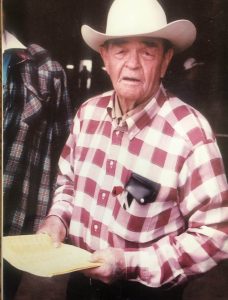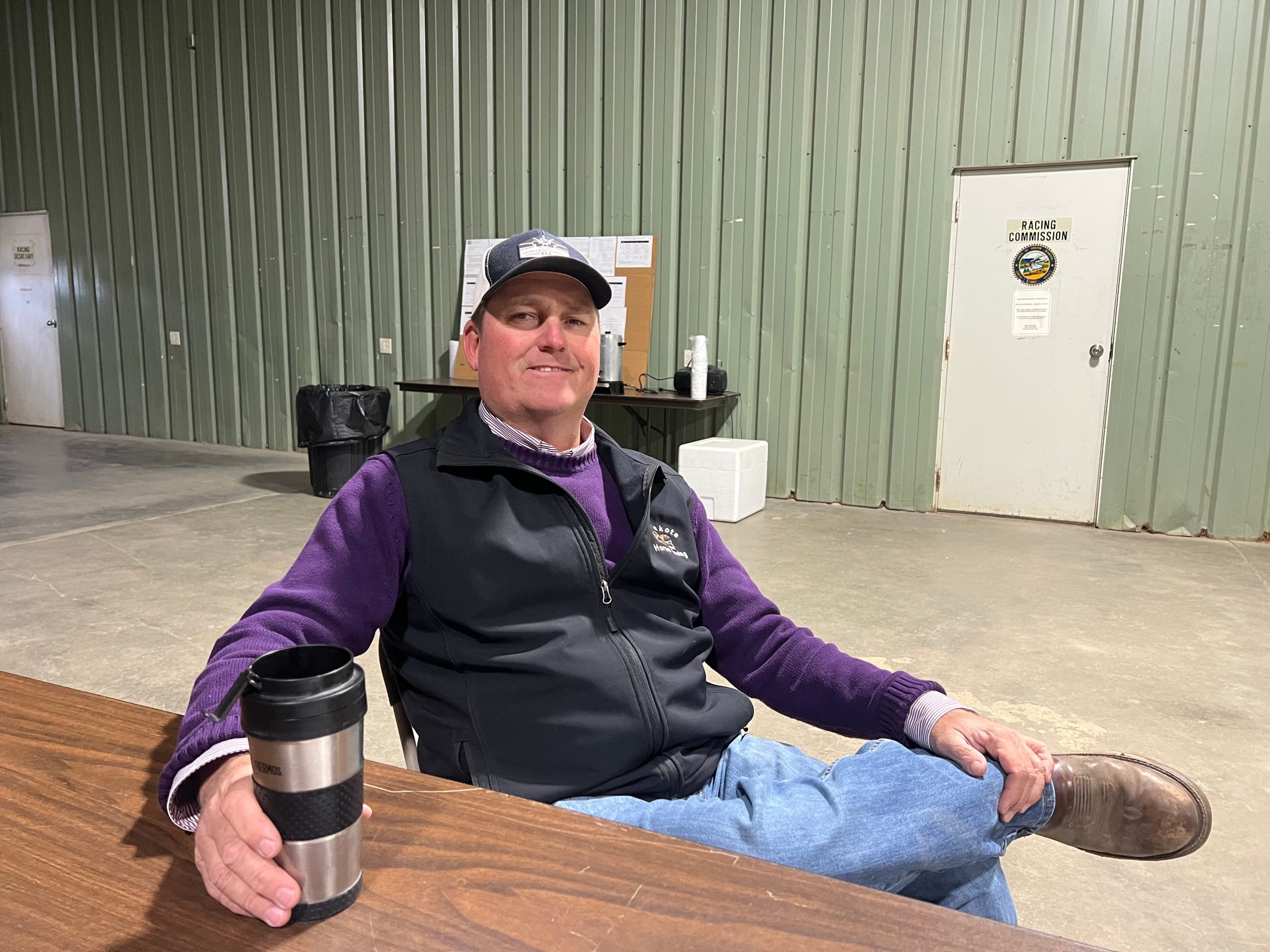(From the archives: an Interview with Shane Kramme for the Fort Pierre News September 29, 2020)
By Sunny Hannum
Friday morning Shane Kramme was at the Stanley County Fairgrounds getting the race track back in shape for what will be a historic fall race meet at Fort Pierre. The eyes of the horse racing people around the country are on this race meet as “it comes at the end of the race season and has big purses.” Kramme has had several interviews in the last few days. Besides this one, he has been interviewed by Tri State Livestock News and East Coast Speed Horse Magazine.
Kramme is a grandson of Everett and Kate Smalley. The Smalleys raced horses on the Fort Pierre track as early as 1948 which was the first race meet sponsored by Verendrye Benevolent Association (VBA). VBA has sponsored the horse races ever since. The Smalleys were living in the Oklahoma Panhandle but bought a ranch south of Fort Pierre in 1953. This ranch is now operated by Kramme and his family.
 Everett Smalley
Everett Smalley
Kramme and a group of volunteers have worked hard the last couple of weeks to assure that the Fort Pierre race meet will be a good experience for trainers and their horses and to also bring them back next year. The last race meet here was in April and May 2018 and after that meet an agreement with the state Gaming Commission and Legislature couldn’t be worked out so there was no spring meet in 2019 or 2020.
This summer the Stanley County Fairgrounds received an extreme makeover to prepare for the State High School Rodeo Finals. Arenas were relocated, track rails removed, and the old crow’s nest torn down. This presented a monumental job for Kramme and his crew to be ready for the Fort Pierre Horse Races October 3rd and 4th. Kramme credits a group of over 15 volunteers for helping him get things ready. He said, “We have used over 50 gallons of paint, cleaned, weeded, set posts and 2 x 6s, even repaired broken boards in the grandstand.”
The track surface has become hard and packed over the past two years. Friday, Jerry Duncan from Minnesota and Kenny Olson from Montana were assisting Kramme in getting a large piece of equipment ready to work the track. This equipment is called a California harrow and it is owned by VBA. It is the same equipment used on the Santa Anita and Canterbury Downs tracks. Kramme said, “The track surface is worked about six inches deep and has to be completely level with no dips or uneven places.”
“Switching from a spring meet to a fall meet” is a strategy that Kramme thinks will not only be good for Fort Pierre but good for the trainers. Horses coming to this meet will be in good shape running at out of state meets over the summer. He said, “Rock Springs, Wyoming just finished their meet September 20th and Prairie Meadows in Iowa is winding down. I have been getting calls from trainers/owners in Utah, California, Arizona, Texas and Nebraska.”
Why all the out of state interest? Kramme said, “The purses are bigger for this meet. For instance, the futurity will have seven 2-year olds running for a purse of $15,000; the derby will have five 3-year olds running for $15,000; the maturity for 4 year olds will be running for a purse of $12,005 and the overnight races (other horses) will be running for a purse of $6,300.
Kramme said, “The money comes out of two South Dakota Horse Racing accounts: the South Dakota Bred Fund which is incentive for South Dakota bred colts and the South Dakota Revolving Fund which is purse monies for other races.” He said, “The idea is to provide incentive for South Dakota bred horses. In the 1990s, there would be over 100 head of two year olds come to Fort Pierre to compete. We have seven two year olds coming to this meet and five three year olds.” Losing the South Dakota meets the last couple of years have really affected the number of South Dakota bred horses.
“This meet will be a little different this year with horses not remaining at the track and barns as long,” said Kramme. “And there will be no need for them to do that because they are coming ready to race. They will enter and draw Tuesday and Wednesday and only the horses making the draw will enter the fairgrounds. Horses that have made the most money over the summer will be the ones to participate.” They will then draw for “High Weights Preferred” or race positions. Numbered marbles are used for the drawing.
Over 100 horses are expected to participate in 15 races Saturday and Sunday October 3rd and 4th. Race time is 1 p.m. Fort Pierre Officials are General Manager Shane Kramme 280-0213; Racing Secretary Kent Cross 605-295-7163; Loyd Just 605-380-2461; State Steward Larry Eliason; Track Steward Doug Runge; Starter Shane Kramme. Entry Contact Info: Kent Cross (605) 295-716 and Melissa Cross (605) 280-1767.
Horse racing in America began in 1665, when the first track was built on Long Island. Organized racing started in 1868, and by 1890 there were 314 operating tracks in the United States. Interest swelled and receded through the years, but two events — the introduction of pari-mutuel wagering in 1908 and the rise of the Triple Crown — were boons to the sport.
Due to the COVID-19 pandemic, the Triple Crown 2020 schedule was turned upside down, with the Kentucky Derby moving from May 2 to September 5, the Preakness Stakes shifting from May 16 to October 3 and the Belmont Stakes shifting from June 6 to June 20.
Several South Dakotans have enjoyed successful careers in horse racing. Among the most famous was Earl Sande, the Groton native who rode Gallant Fox to the Triple Crown in 1930. Trainer Steve Asmussen became only the second trainer in thoroughbred racing history to win for the 9,000th time in his career, bringing home Troy Ounce in race two Friday night at Remington Park.
Asmussen needs 446 more victories to become the all-time winningest trainer in North American thoroughbred history and trained Curlin, winner of the 2007 Preakness Stakes and the Breeders Cup Classic, considered the Super Bowl of thoroughbred horse racing. Bill Mott, of Mobridge, worked with Cigar, who won 16 consecutive races in 1995 and 1996 and retired as the top money earner in thoroughbred racing history. Mott has been voted national leading trainer three times and was the youngest trainer ever inducted to the National Racing Hall of Fame.
Sanctioned horse racing at Fort Pierre’s track dates to the 1940s and they’ve been running for decades in Aberdeen. But centuries earlier Native Americans were racing their horses on the Missouri River bottoms near Fort Pierre. Early drawings from 1832 by Karl Bodmer at Fort Pierre Chouteau show natives racing their horses. An early history book tells of spectators gathering to watch a horse race between a horse owned by Scotty Philip and a challenger.
South Dakota’s modern horse racing system is supported entirely through simulcast wagering, allowing bettors at two or more sites to bet into the same pool. South Dakota’s two simulcast wagering hosts are the Time Out Lounge in Rapid City and the Triple Crown Casino in North Sioux City. The South Dakota Commission on Gaming regulates all pari-mutuel wagering, though no tax dollars support horse racing. The commission is required by law to disburse money generated back into the racing industry through the South Dakota-bred racing fund and another revolving fund.


